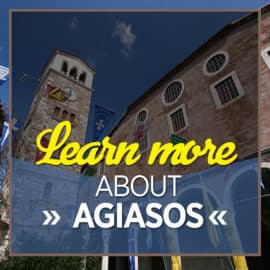This exhibition presents the traditional profession of the shoemaker
in Agiasos.
Before wearing shoes was popular, the farmers wore the so-called “tsirovoulia”, which were a kind of “tsarouchia” (old traditional greek shoes). They were made themselves or by the “tsivourlades” (shoe makers).
The profession of shoemakers
Until the 1950s and 1960s, the shoemaking profession was considered one of the most lucrative, as there were not many mass-produced factories yet, so almost all families bought their shoes from a shoemaker.
A pair of soles cost 80 drachmas, when the daily wage of a worker did not exceed 70 drachmas. Thus, there were many families who sent their children to learn the art as helpers.
They usually started at a young age since from the 19th to the middle of the 20th century, very few children could afford to go to school.
In the city of Chios there were several professional shoemakers, where in each village there was at least one, while in the larger villages there were usually two or three. The same was true for Mytilene and the rest of Lesvos.
“Papoutsades” or “Tsagkarades”?
There were two types of shoemakers: those who made new shoes, the so-called “papoutsades” (the shoemakers), and those who made “patches”, ie repairs and soles, the “tsagkarades” (the makers of patches).
This distinction is quite general, as it does not mean that those who made new shoes did not know how to repair old ones and vice versa, while they usually chose their own specialization.
Of course those who made shoes were paid better, but they had fewer orders than those they repaired.
The shoemakers (“papoutsades”) of Lesvos
Shoemakers were a very important profession for the local communities of Lesvos due to the increased needs of the farmers. It should be noted that, until the middle of the 20th century, most families bought new shoes only when the old ones could not be repaired anymore.
Since there were usually several shoemakers in each area or village, each one specialized in a different type of shoe.
For example, one made the “scoliana”, ie luxury shoes (such as heels or slippers), another made the “rustic” for the countryside or work, so there was no particular competition between them since, as the old saying goes, each one had “his customers and his art “.
Old unions of the shoemakers in Lesvos and Chios
In Chios the “shoemakers” were initially organized in three unions: one belonged to those who made the “good” shoes (women’s and men’s), the second to those who made the “rustic” shoes, while there was a third union which belonged to the workers who worked in the shops as helpers.
The union of the shoemakers or shoemakers of luxury shoes had Agios Dimitris as its patron – Saint, while the association of the “papoutsades” who made the “rustic” had Agios Diomidis. Both of them had built their own churches.
The third union, that of the workers, participated in the celebrations of the other two.
Over the years, however, the two unions merged, celebrating both St. Demetrius on October 26 and St. Diomedes on August 26 in both churches. There was a similar association in Mytilene.
The shoemaker’s tools and materials
Tools
The cobblers primarily used the “kalapodi”, that is, a wooden mold of a shoe, to make the new shoe “on” it. There were many different shapes like pointed, female, male, etc. The order with the numbers was called “mother”.
Their tools were the wooden tacks, the “katsambroki”, the “souvli” (skewer), the small pliers, the “cat” or large pliers, the hook, the file and the shoeknife with which they cut the excess skin.
Materials
As materials, they used leather, wax and glue.
The time it took to make a pair of shoes was about two days.
The traditional shoemaking process
The leather was chosen by the customer according to his financial ability, while the procedure was as follows: they took the “kalapodi” and drew the design of the wooden mold they wanted on paper. Then they put the design on the skin, cut it and the “stampo” (that is, the template) came out. The “stampo” was sent to the “fontieri”, who was the specialist to sew the “fontia” (foundations) which were the leathers on the upper part of the shoe.
When the “fontia” were ready, they made the bottom from thin leather which was called the “skin”.
They put the “skin” on the bottom of the shoe and nailed it with thin wooden pegs. Then the “fontia” were carefully nailed to the shoe.
After that, they used glue all around the “kalapodi” and crushed the tacks. From there they let it dry.
When it was dry, they spread the “fonti” (adjective of “fontia”) with a flat hammer on the “kalapodi” so that it would not have wrinkles, while then they also cut the excess leather of the bottom with the bevel.
This was followed by the “refilling” of the skin: they hit it again with a hammer to make it as smooth as possible, while they sewed the shoe sole with the “fonti” to make it hold strongly.
Finally they brushed the skin and smeared it with wax.
Today
Today, after the rapid industrial production of footwear, the particular craft of shoemaking did not stand the test of time but you can still find small shops around Lesvos operated by seniors, masters of the craft ready to repair any shoe, some of them even by using the traditional shoemaking tools!






